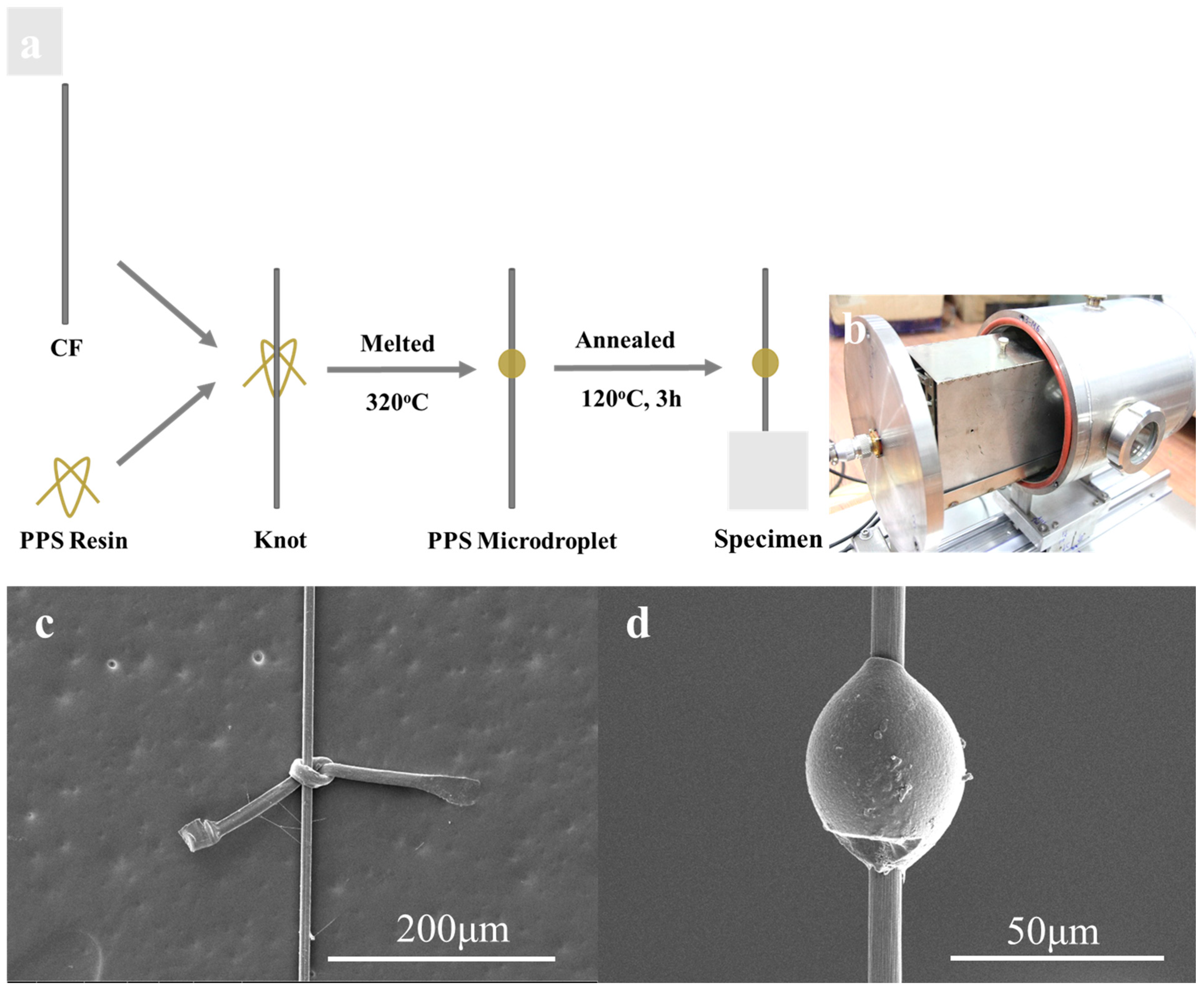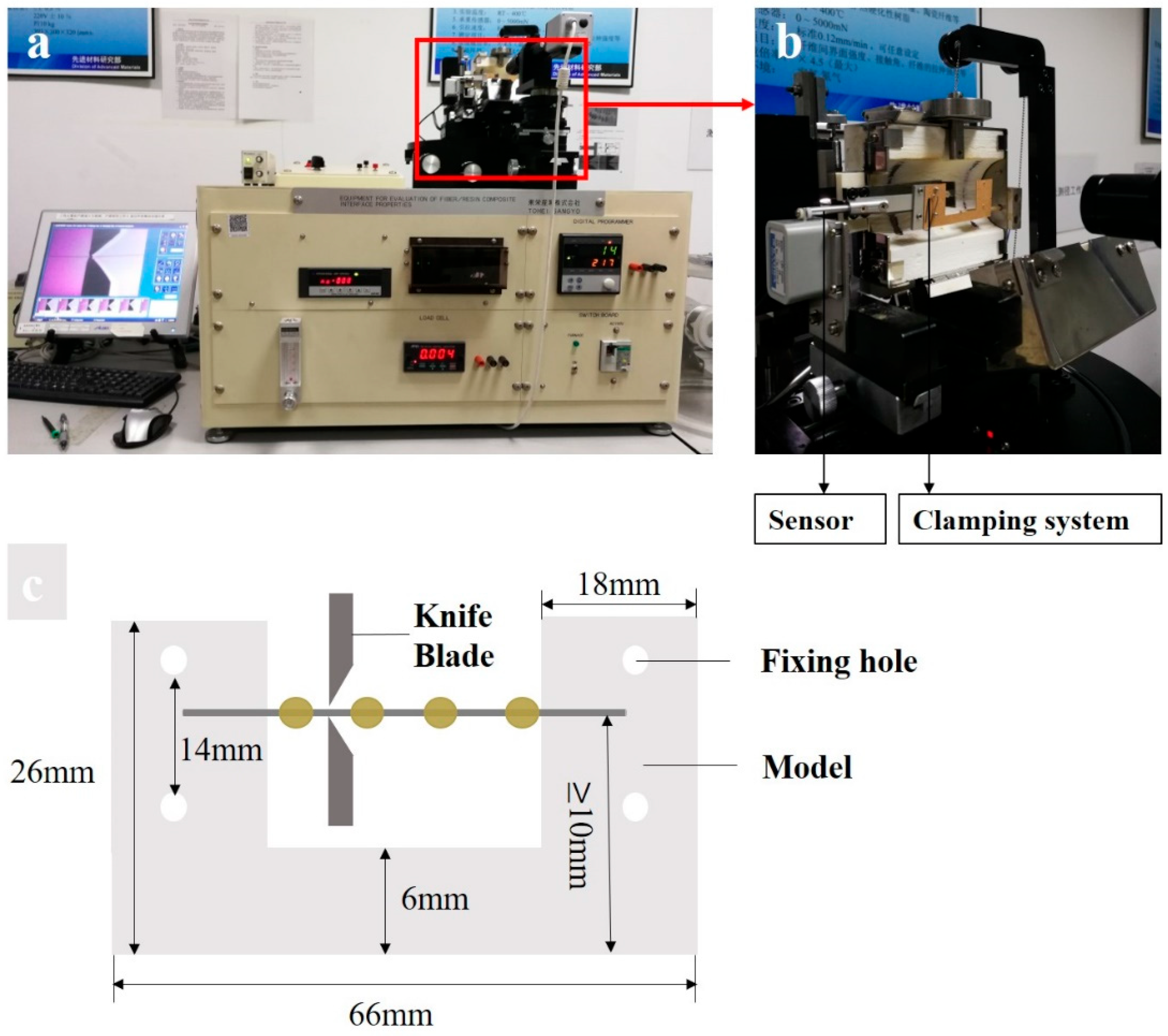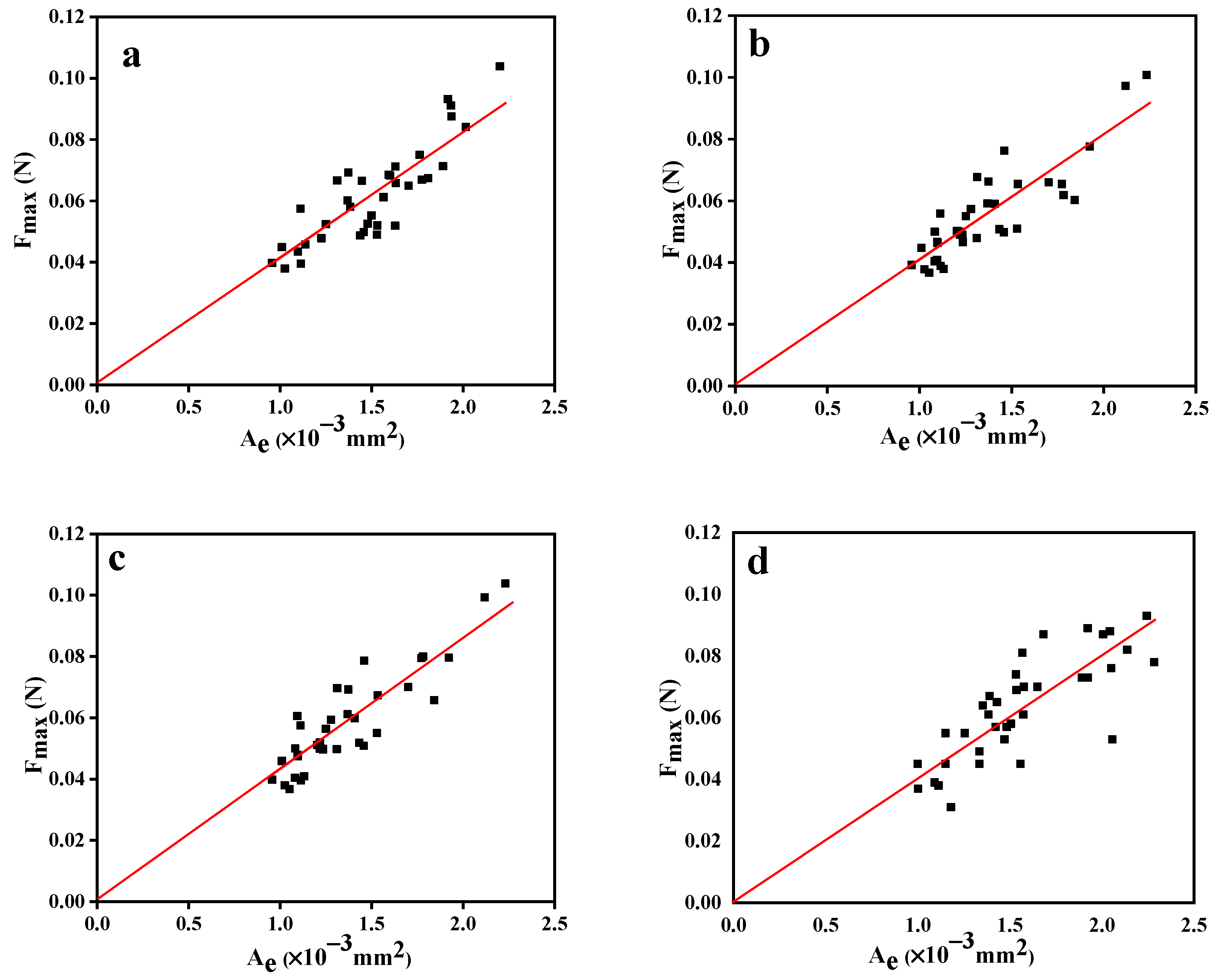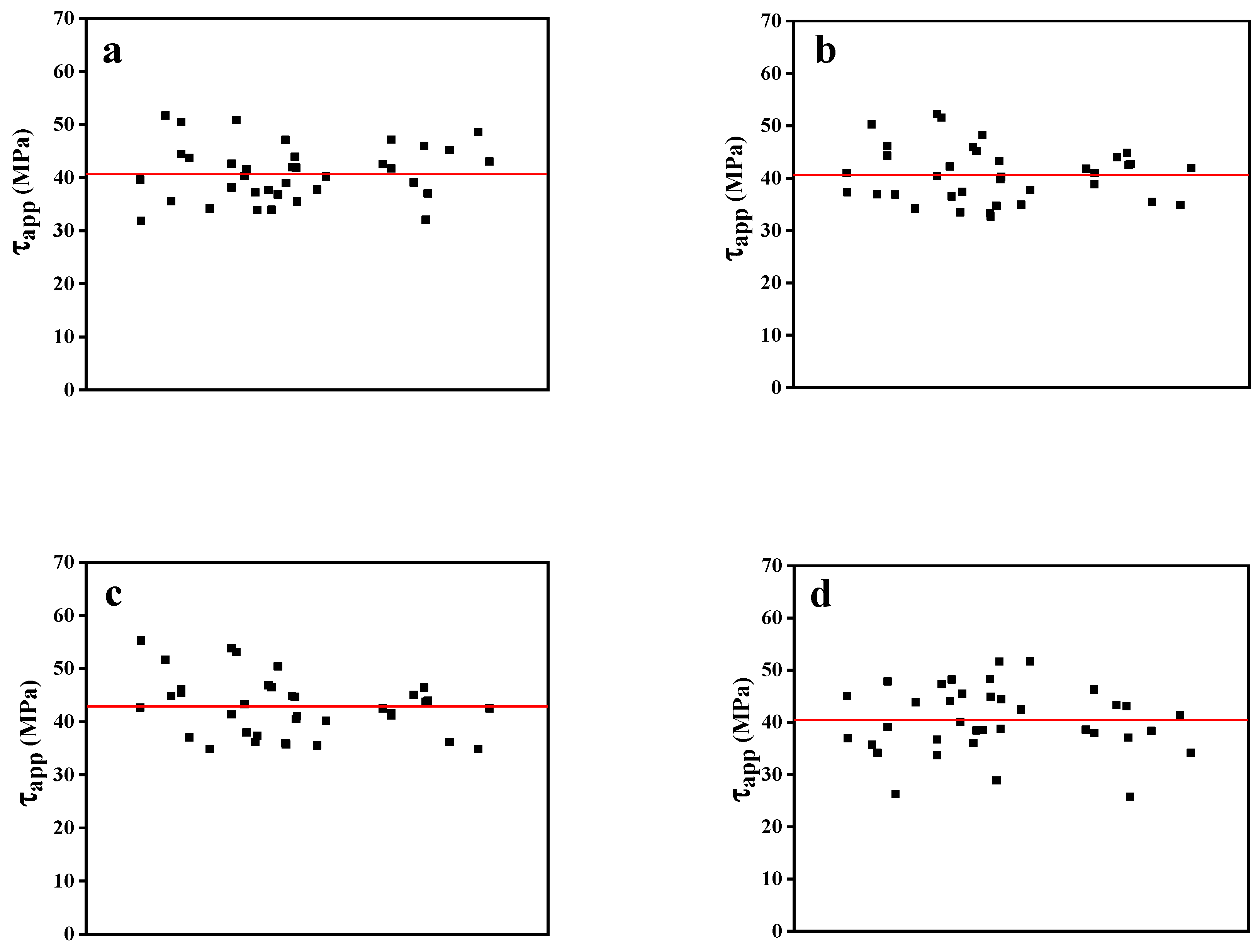Improvement and Evaluation of a Device That Determines the Interfacial Shear Strength of Carbon Fiber/Polyphenylene Sulfide Composites
Abstract
:1. Introduction
2. Design and Manufacture of the Generation II Experimental Apparatus
3. Experimental Methods
3.1. Materials
3.2. Sample Preparation
3.3. Experimental Procedure
3.4. Comparison of Instruments
4. Results and Discussion
4.1. Samples’ Morphologies
4.2. IFSS of PPS/CF Composites
5. Conclusions
Author Contributions
Funding
Institutional Review Board Statement
Data Availability Statement
Conflicts of Interest
References
- Rajak, D.K.; Wagh, P.H.; Linul, E. Manufacturing technologies of carbon/glass fiber-reinforced polymer composites and their properties: A review. Polymers 2021, 13, 3721. [Google Scholar] [CrossRef] [PubMed]
- Yao, S.S.; Jin, F.L.; Rhee, K.Y.; Hui, D.; Park, S.J. Recent advances in carbon-fiber-reinforced thermoplastic composites: A review. Compos. Part B Eng. 2018, 142, 241–250. [Google Scholar] [CrossRef]
- Soutis, C. Carbon fiber reinforced plastics in aircraft construction. Mater. Sci. Eng. A 2005, 412, 171–176. [Google Scholar] [CrossRef]
- Kim, D.H.; Choi, D.H.; Kim, H.S. Design optimization of a carbon fiber reinforced composite automotive lower arm. Compos. Part B: Eng. 2014, 58, 400-407. [Google Scholar] [CrossRef]
- Liu, Y.; Zwingmann, B.; Schlaich, M. Carbon fiber reinforced polymer for cable structures—A review. Polymers 2015, 7, 2078–2099. [Google Scholar] [CrossRef]
- Sharma, M.; Gao, S.; Mäder, E.; Sharma, H.; Wei, L.Y.; Bijwe, J. Carbon fiber surfaces and composite interphases. Compos. Sci. Technol. 2014, 102, 35–50. [Google Scholar] [CrossRef]
- Li, H.; Wang, Y.; Zhang, C.; Zhang, B. Effects of thermal histories on interfacial properties of carbon fiber/polyamide 6 composites: Thickness, modulus, adhesion and shear strength. Compos. Part A Appl. Sci. Manuf. 2016, 85, 31–39. [Google Scholar] [CrossRef]
- Liu, L.; Jia, C.; He, J.; Zhao, F.; Fan, D.; Xing, L.; Wang, M.; Wang, F.; Jiang, Z.; Huang, Y. Interfacial characterization, control and modification of carbon fiber reinforced polymer composites. Compos. Sci. Technol. 2015, 121, 56–72. [Google Scholar] [CrossRef]
- Tripathi, D.; Jones, F.R. Single fibre fragmentation test for assessing adhesion in fibre reinforced composites. J. Mater. Sci. 1998, 33, 1–16. [Google Scholar] [CrossRef]
- Yao, T.T.; Wu, G.P.; Song, C. Interfacial adhesion properties of carbon fiber/polycarbonate composites by using a single-filament fragmentation test. Compos. Sci. Technol. 2017, 149, 108–115. [Google Scholar] [CrossRef]
- Tandon, G.P.; Pagano, N.J. Micromechanical analysis of the fiber push-out and re-push test. Compos. Sci. Technol. 1998, 58, 1709–1725. [Google Scholar] [CrossRef]
- Chandra, N.; Ghonem, H. Interfacial mechanics of push-out tests: Theory and experiments. Compos. Part A Appl. Sci. Manuf. 2001, 32, 575–584. [Google Scholar] [CrossRef]
- Sørensen, B.F.; Lilholt, H. Fiber pull-out test and single fiber fragmentation test-analysis and modelling. In IOP Conference Series: Materials Science and Engineering, Proceedings of the 37th Risø International Symposium on Materials Science, Risø, Denmark, 5–8 September 2016; IOP Publishing: Bristol, UK, 2016; Volume 139, p. 012009. [Google Scholar]
- Miller, B.; Muri, P.; Rebenfeld, L. A microbond method for determination of the shear strength of a fiber/resin interface. Compos. Sci. Technol. 1987, 28, 17–32. [Google Scholar] [CrossRef]
- Graupner, N.; Rößler, J.; Ziegmann, G.; Müssig, J. Fibre/matrix adhesion of cellulose fibres in PLA, PP and MAPP: A critical review of pull-out test, microbond test and single fibre fragmentation test results. Compos. Part A Appl. Sci. Manuf. 2014, 63, 133–148. [Google Scholar] [CrossRef]
- Dong, Y.; Yu, T.; Wang, X.J.; Zhang, G.; Lu, J.H.; Zhang, M.L.; Long, S.; Yang, J. Improved interfacial shear strength in polyphenylene sulfide/carbon fiber composites via the carboxylic polyphenylene sulfide sizing agent. Compos. Sci. Technol. 2020, 190, 108056. [Google Scholar] [CrossRef]
- Sockalingam, S.; Nilakantan, G. Fiber-matrix interface characterization through the microbond test. Int. J. Aeronaut. Space Sci. 2012, 13, 282–295. [Google Scholar] [CrossRef]
- Herrera-Franco, P.J.; Drzal, L.T. Comparison of methods for the measurement of fibre/matrix adhesion in composites. Composites 1992, 23, 2–27. [Google Scholar] [CrossRef]
- Zhi, C.; Long, H.; Miao, M. Influence of microbond test parameters on interfacial shear strength of fiber reinforced polymer-matrix composites. Compos. Part A Appl. Sci. Manuf. 2017, 100, 55–63. [Google Scholar] [CrossRef]
- Zhao, Q.; Qian, C.C.; Harper, L.T.; Warrior, N.A. Finite element study of the microdroplet test for interfacial shear strength: Effects of geometric parameters for a carbon fibre/epoxy system. J. Compos. Mater. 2018, 52, 2163–2177. [Google Scholar] [CrossRef]
- Craven, J.P.; Cripps, R.; Viney, C. Evaluating the silk/epoxy interface by means of the microbond test. Compos. Part A Appl. Sci. Manuf. 2000, 31, 653–660. [Google Scholar] [CrossRef]
- Zhi, C.; Long, H.; Miao, M. Microbond testing and finite element simulation of fibre-microballoon-epoxy ternary composites. Polym. Test. 2018, 65, 450–458. [Google Scholar] [CrossRef]
- Wang, H.; Wang, H.; Li, W.; Ren, D.; Yu, Y. An improved microbond test method for determination of the interfacial shear strength between carbon fibers and epoxy resin. Polym. Test. 2013, 32, 1460–1465. [Google Scholar] [CrossRef]
- Laurikainen, P.; Kakkonen, M.; Von Essen, M.; Tanhuanpää, O.; Kallio, P.; Sarlin, E. Identification and compensation of error sources in the microbond test utilising a reliable high-throughput device. Compos. Part A Appl. Sci. Manuf. 2020, 137, 105988. [Google Scholar] [CrossRef]
- Wagner, H.D.; Gallis, H.E.; Wiesel, E. Study of the interface in Kevlar 49-epoxy composites by means of microbond and fragmentation tests: Effects of materials and testing variables. J. Mater. Sci. 1993, 28, 2238–2244. [Google Scholar] [CrossRef]
- Hodzic, A.; Kalyanasundaram, S.; Lowe, A.; Stachurski, Z.H. The microdroplet test: Experimental and finite element analysis of the dependence of failure mode on droplet shape. Compos. Interfaces 1998, 6, 375–389. [Google Scholar] [CrossRef]
- Pandey, G.; Kareliya, C.H.; Singh, R.P. A study of the effect of experimental test parameters on data scatter in microbond testing. J. Compos. Mater. 2012, 46, 275–284. [Google Scholar] [CrossRef]
- Gaur, U.; Miller, B. Microbond method for determination of the shear strength of a fiber/resin interface: Evaluation of experimental parameters. Compos. Sci. Technol. 1989, 34, 35–51. [Google Scholar] [CrossRef]
- Yang, L.; Thomason, J.L. Development and application of micromechanical techniques for characterising interfacial shear strength in fibre-thermoplastic composites. Polym. Test. 2012, 31, 895–903. [Google Scholar] [CrossRef]
- Yang, L.; Thomason, J.L. Interface strength in glass fibre–polypropylene measured using the fibre pull-out and microbond methods. Compos. Part A Appl. Sci. Manuf. 2010, 41, 1077–1083. [Google Scholar] [CrossRef]
- Le Duigou, A.; Davies, P.; Baley, C. Interfacial bonding of flax fibre/poly(L-lactide) bio-composites. Compos. Sci. Technol. 2010, 70, 231–239. [Google Scholar] [CrossRef]
- Liu, B.; Liu, Z.; Wang, X.; Zhang, G.; Long, S.; Yang, J. Interfacial shear strength of carbon fiber reinforced polyphenylene sulfide measured by the microbond test. Polym. Test. 2013, 32, 724–730. [Google Scholar] [CrossRef]
- Huang, S.Y.; Wu, G.P.; Chen, C.M.; Yang, Y.; Zhang, S.C.; Lu, C.X. Electrophoretic deposition and thermal annealing of a graphene oxide thin film on carbon fiber surfaces. Carbon 2013, 52, 613–616. [Google Scholar] [CrossRef]
- Lei, C.; Zhao, J.; Zou, J.; Jiang, C.; Li, M.; Zhang, X.; Zhang, Z.; Li, Q. Assembly dependent interfacial property of carbon nanotube fibers with epoxy and its enhancement via generalized surface sizing. Adv. Eng. Mater. 2016, 18, 839–845. [Google Scholar] [CrossRef]
- Rahate, A.S.; Nemade, K.R.; Waghuley, S.A. Polyphenylene sulfide (PPS): State of the art and applications. Rev. Chem. Eng. 2013, 29, 471–489. [Google Scholar] [CrossRef]
- Wang, X.; Xu, D.; Liu, H.Y.; Zhou, H.; Mai, Y.W.; Yang, J.; Li, E. Effects of thermal residual stress on interfacial properties of polyphenylene sulphide/carbon fibre (PPS/CF) composite by microbond test. J. Mater. Sci. 2016, 51, 334–343. [Google Scholar] [CrossRef]
- Thomason, J.L.; Yang, L. Temperature dependence of the interfacial shear strength in glass–fibre polypropylene composites. Compos. Sci. Technol. 2011, 71, 1600–1605. [Google Scholar] [CrossRef]
- Wang, Z.; Dong, Y.; Yang, J.C.; Wang, X.J.; Zhang, M.L.; Zhang, G.; Long, S.; Liu, S.; Yang, J. Improved interfacial shear strength in carbon fiber enhanced semi-aromatic polyamide 6T composite via in-situ polymerization on fiber surface. Compos. Sci. Technol. 2022, 223, 109401. [Google Scholar] [CrossRef]
- Zhang, T.; Wang, Z.; Zhang, G.; Liu, S.L.; Long, S.R.; Yang, J.; Yang, J.; Wang, X.J. Improvement of interfacial interaction between poly (arylene sulfide sulfone) and carbon fiber via molecular chain grafting. Compos. Sci. Technol. 2022, 224, 109463. [Google Scholar] [CrossRef]







| Device | Generation I Device | Generation II Device | |
|---|---|---|---|
| Clamping system | Flat clip | Curved clip | |
| Observation system | Microscope | Free-zoom horizontal | Zoomable horizontal microscope |
| Measurement | Separated from test | Combined with test online | |
| Tensile system | Motor | Stepper motor | Servo motor |
| Sensor | Sartorius BSA323S | Sartorius BSA423S | |
| Heating system | Temperature | RT-160 °C | −20–300 °C |
| Device | Generation I Device | Generation II Device | Toei Device | |
|---|---|---|---|---|
| The magnification of microscopes (max) | 160X | 300X | 4.5X | |
| Blades | Plane | Plane | Obtuse angle surface | |
| The test process | Direction | Vertical | Vertical | Horizontal |
| The range of pulling rate | 0.01–1 mm/min | 0.001–2 mm/min | 0.12 mm/min (default) | |
| Collection of data | precision | 0.001 g | 0.001 g | 0.01 mN |
| Recorded frequency (s) | 0.1 | 0.1 | 0.125 | |
| Device | (MPa) | STDEV | |
|---|---|---|---|
| Generation I device | 41.06 | 40.94 | 5.27 |
| Generation II device (no catcher) | 40.69 | 40.68 | 5.23 |
| Generation II device (involved catcher) | 43.01 | 42.81 | 5.54 |
| Toei tester | 40.18 | 40.41 | 6.36 |
Disclaimer/Publisher’s Note: The statements, opinions and data contained in all publications are solely those of the individual author(s) and contributor(s) and not of MDPI and/or the editor(s). MDPI and/or the editor(s) disclaim responsibility for any injury to people or property resulting from any ideas, methods, instructions or products referred to in the content. |
© 2023 by the authors. Licensee MDPI, Basel, Switzerland. This article is an open access article distributed under the terms and conditions of the Creative Commons Attribution (CC BY) license (https://creativecommons.org/licenses/by/4.0/).
Share and Cite
Dong, Y.; Yang, J.-C.; Wang, X.-J.; Zhang, G.; Zhang, M.-L.; Wei, Z.-M.; Long, S.-R.; Yang, J. Improvement and Evaluation of a Device That Determines the Interfacial Shear Strength of Carbon Fiber/Polyphenylene Sulfide Composites. Polymers 2023, 15, 3749. https://doi.org/10.3390/polym15183749
Dong Y, Yang J-C, Wang X-J, Zhang G, Zhang M-L, Wei Z-M, Long S-R, Yang J. Improvement and Evaluation of a Device That Determines the Interfacial Shear Strength of Carbon Fiber/Polyphenylene Sulfide Composites. Polymers. 2023; 15(18):3749. https://doi.org/10.3390/polym15183749
Chicago/Turabian StyleDong, Yuan, Jia-Cao Yang, Xiao-Jun Wang, Gang Zhang, Mei-Lin Zhang, Zhi-Mei Wei, Sheng-Ru Long, and Jie Yang. 2023. "Improvement and Evaluation of a Device That Determines the Interfacial Shear Strength of Carbon Fiber/Polyphenylene Sulfide Composites" Polymers 15, no. 18: 3749. https://doi.org/10.3390/polym15183749







